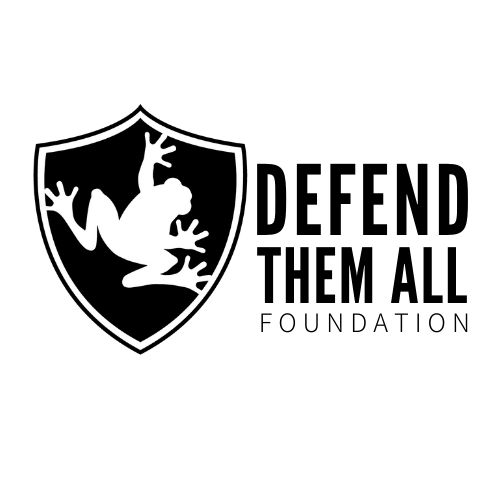Species Spotlight: Greater Sage-Grouse
Photo Credit: Jeannie Stafford/USFWS
A greater sage-grouse male struts at a lek (dancing or mating ground) near Bridgeport, CA to attract a mate.
Common name: Greater Sage-Grouse
Scientific name: Centrocercus urophasianus
Range: Western United States, southern Alberta and Saskatchewan, Canada
Conservation status: Near Threatened on the IUCN Red List
Information
The Greater Sage-Grouse (Centrocercus urophasianus) is the largest North American grouse species (Fish and Wildlife Service). Greater Sage-Grouse have a chubby, round body, small head, and long tails (All About Birds). Adult males are mottled gray-brown, with a black belly, head, and throat, with a yellow patch over each eye (All About Birds). Their breast is white, with two yellow sacs on the neck that are inflated during courtship displays (All About Birds). Adult males range in length from 26 to 30 inches and weigh between 4 and 7 pounds (Fish and Wildlife Service). Adult females are speckled brown and gray, with a black belly (All About Birds). Adult females, smaller than their male counterparts, range in length from 19 to 23 inches and weigh between 2 and 4 pounds (Fish and Wildlife Service).
The Sage-Grouse is most known for its unique mating dance. During the spring breeding season, adult males perform courtship displays, while groups of females observe the displays and select the most attractive males with whom to mate (Fish and Wildlife Service). These rituals are performed in the early spring in areas known as leks, which are often surrounded by dense shrub-steppe cover (Fish and Wildlife Service). Key factors influencing lek locations for mating rituals include proximity, configuration, and abundance of nesting habitats (Fish and Wildlife Service). Leks may be used for years as display grounds (Audubon). After breeding, the hens leave the lek for the nesting grounds and nest under sagebrush or clumps of grass (Audubon). The females will usually lay between 7 to 9 eggs, sometimes 6 to 13, which are incubated by the female for 25 to 27 days (Audubon). Sage-Grouse typically live between 3 and 6 years, but can live up to 9 years of age in the wild (Fish and Wildlife Service).
Threats and Conservation
Their historic range spanned 13 American states and 3 Canadian provinces—Washington, Oregon, California, Nevada, Idaho, Montana, Wyoming, Colorado, Utah, South Dakota, North Dakota, Nebraska, British Columbia, Alberta, and Saskatchewan (Fish and Wildlife Service). However, the Greater Sage-Grouse population is located in 11 American states and 2 Canadian provinces—Washington, Oregon, California, Nevada, Idaho, Montana, Wyoming, Colorado, Utah, South Dakota, and North Dakota, Alberta, and Saskatchewan (Fish and Wildlife Service). They only occupy approximately 56 percent of their historical range, with approximately 2 percent of the total range occurring in Canada, with the remainder in the United States. (Fish and Wildlife Service). Populations of Greater Sage-Grouse have declined by 80% rangewide since 1965 and nearly 40% since 2002 (U.S. Geological Survey). Despite these significant declines, the bird is not listed under the Endangered Species Act.
IUCN’s designation of the species as “near threatened” is attributed to the continuing and moderately rapid decline of the population (IUCN). Currently, there are approximately 150,000 Sage-Grouse left due to large-scale habitat loss (IUCN). Cleared and degraded habitat loss due to cultivation, burning, overgrazing, and further development of natural gas resources have all negatively impacted the Sage-Grouse population (IUCN). Wildfires that burn Sage-Grouse habitat take a very long time to regrow, ranging from 35 to 50 years after a fire (Parks). The Sage-Grouse has strong site fidelity, meaning they are loyal to the particular area even when the area is no longer of value (Fish and Wildlife Service). Therefore, changes to their habitat are extremely detrimental to the population.
The Obama Administration temporarily enacted a plan to withdraw sagebrush focal areas from mining and drilling, but called for a full environmental review to make the withdrawal permanent. The Trump Administration abandoned that plan, planning to open 10 million acres for economic developments (Renda). U.S. District Court Judge Lynn Winmall granted summary judgment to the Western Watersheds Project, finding the Bureau of Land Management failed to provide a legal rationale for the federal government's sudden withdrawal in the need to protect the iconic bird’s habitat from hard-rock mining in the American West (Renda). The federal judge’s decision to vacate the Trump Administration’s decision requires that the BLM restart the environmental review process (Federal Register). Soon, the BLM will issue a new draft Environmental Impact Statement (EIS) and publish a Notice of Availability (NOA) initiating a public comment period that would allow the BLM to reconsider protecting 10 million acres of Sage-Grouse habitat (Federal Register).
References
All About Birds. n.d. Greater Sage-Grouse. [online] Available at: <https://www.allaboutbirds.org/guide/Greater_Sage-Grouse/id>.
Audubon. n.d. Greater Sage-Grouse. [online] Available at: <https://www.audubon.org/field-guide/bird/greater-sage-grouse>.
The IUCN Red List of Threatened Species. 2016. Centrocercus urophasianus. [online] Available at: <https://www.iucnredlist.org/species/22679503/92816586>.
Federal Register. 2021. Notice to Re-Initiate Proposed Withdrawal; Sagebrush Focal Areas. [online] Available at: <https://www.federalregister.gov/documents/2021/08/13/2021-17359/notice-to-re-initiate-proposed-withdrawal-sagebrush-focal-areas>.
Fish and Wildlife Service. n.d. Beginner's Guide to Greater Sage-Grouse. [online] Available at: <https://www.fws.gov/greatersagegrouse/factsheets/primer1-sgbeginnersguide.pdf.>.
Renda, M., 2021. Judge Saves Sage Grouse Habitat From Trump Mining Plans. [online] Courthouse News Service. Available at: <https://www.courthousenews.com/judge-saves-sage-grouse-habitat-from-trump-mining-plans/>.
Parks, B., 2021. US Bureau of Land Management reconsiders protecting 10 million acres of sage grouse habitat. [online] Oregon Public Broadcasting. Available at: <https://www.opb.org/article/2021/08/13/sage-grouse-mining-drilling-protection/>.
U.S. Geological Survey. 2021. Range-wide Greater Sage-Grouse Hierarchical Monitoring Framework: Implications for Defining Population Boundaries, Trend Estimation, and a Targeted Annual Warning System. [online] Available at: <https://pubs.er.usgs.gov/publication/ofr20201154>.
W. Watersheds Project v. Bernhardt, No. 1:16-cv-00083-BLW, 2021 U.S. Dist. LEXIS 27434 (D.Idaho Feb. 11, 2021).


